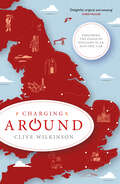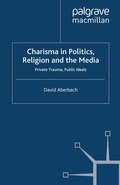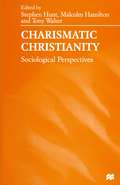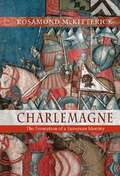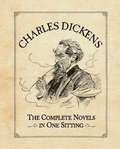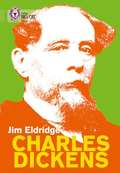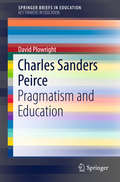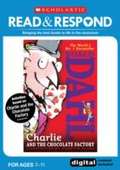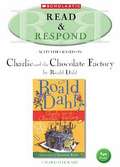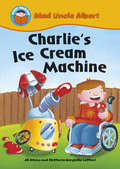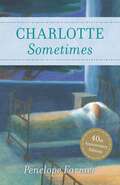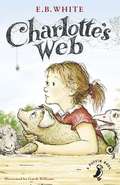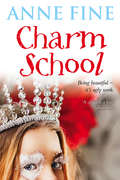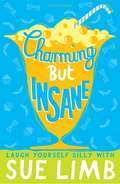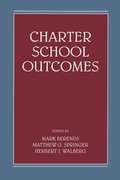- Table View
- List View
Charging Around: Exploring the Edges of England by Electric Car
by Clive Wilkinson‘A delightful, original, amusing tour of some of the UK’s less explored places’ – Chris MullinHaving crossed a continent by train and sailed around the world by container ship, Clive Wilkinson has always had a penchant for slow travel. As his eightieth birthday approaches, he and his wife Joan set out on a new expedition: to tour the edges of England by electric car. How hard could that be?Given the parlous state of the country’s charge-point infrastructure back in 2018, the answer turns out to be ‘very’. In a 1,900-mile odyssey through fading seaside towns, rainswept hilltop passes and England’s only desert, each day’s driving for these unlikely pioneers is overshadowed by a cloud of apprehension. Will they make it to the next charge point? Will it be in working order? Will someone else be using it?You could only undertake such a trip with a calm temperament and robust sense of humour. Fortunately, Clive has both. With a relentless curiosity for history, geography and, above all, people, he and Joan explore the reality of life on England’s periphery – the ‘left behind’ areas that, by voting for Brexit, changed the course of British history – making new friends with every mile.
Charisma in Politics, Religion and the Media: Private Trauma, Public Ideals
by D. AberbachWhat are the origins of charisma? Are these the same in the various forms of public life, in politics and the media as well as in religion? In this new and radical interpretation of charisma, David Aberbach argues that the basis of charisma in all its forms must be found in the often-obscure symbolic intersection between the inner world of the charismatic and external social and political reality. As illustrations of various facets of this argument, he provides general analyses of charisma in politics, religion and the media as well as individual studies of Churchill, Hitler, Krishnamurti, Bialik and Chaplin.
Charismatic Christianity: Sociological Perspectives
by Stephen J. Hunt Tony Walter Malcolm HamiltonThe charismatic movement has a high profile in contemporary Christianity. The book's contributors include insiders and outsiders, charismatics and sociologists; with Britain as their focus, they trace the movement's international connections, historical development and variety. The book provides a wealth of information and analysis which will interest both those within the movement and students of religion wanting to know more about it.
Charles Dickens: The Complete Novels in One Sitting (RP Minis)
by Joelle HerrCelebrate the bicentennial birthday of Charles Dickens with this Miniature Edition packed with witty summaries of the novels of one of history's most beloved storytellers. All fans of great literature can enjoy these perfectly portable renditions of Oliver Twist, A Christmas Carol, Great Expectations, A Tale of Two Cities, and all the Dickensian classics. Featuring synopses, character profiles, and illustrations, this mini book brings to life twenty classic tales and the iconic characters that populate the world of Dickens.
Charles Dickens: The Complete Novels in One Sitting (RP Minis)
by Joelle HerrCelebrate the bicentennial birthday of Charles Dickens with this Miniature Edition packed with witty summaries of the novels of one of history's most beloved storytellers. All fans of great literature can enjoy these perfectly portable renditions of Oliver Twist, A Christmas Carol, Great Expectations, A Tale of Two Cities, and all the Dickensian classics. Featuring synopses, character profiles, and illustrations, this mini book brings to life twenty classic tales and the iconic characters that populate the world of Dickens.
Charles Dickens: Band 11/Lime (Collins Big Cat)
by Jim Eldridge Mark Oldroyd Collins Big CatCharles Dickens was a famous writer who lived in the 19th century. Discover what life was like for Charles, from spending his childhood working in a factory to finding a job as a law clerk and starting his writing career in this biography by Jim Eldridge.
Charles Sanders Peirce: Pragmatism and Education (SpringerBriefs in Education)
by David PlowrightThis book introduces a number of selected ideas from the work of Charles Sanders Peirce, the founder of pragmatism. Peirce, pronounced ‘purse’, was born in America in 1839 and died in 1914. He published little in his own lifetime and he continually struggled to become recognised as a respected author with ideas that were highly creative, original and unique. The book begins with an examination of Peirce’s life history. This is followed by an explanation of pragmatism, which states that an understanding of a concept can only be fully grasped by knowing what its practical effects are. The author then explains a number of Peirce’s ideas that are based on his pragmatic maxim: · scientific inquiry as a method of investigation and its relevance to everyday thinking· inferential thinking based on abduction, deduction and induction and its use in educational research· semiotics, the study of signs and its relevance to the development of conceptual understanding· his profound and insightful ontological categories of Firstness, Secondness and Thirdness and their application to developing an understanding of the world around usThis introductory text is written in a clear and accessible style. Numerous examples are used throughout the book to illustrate Peirce’s complex and sophisticated ideas and to show how his thinking can be applied to education.
The Charleston Orphan House: Children's Lives in the First Public Orphanage in America (Markets and Governments in Economic History)
by John E. MurrayThe first public orphanage in America, the Charleston Orphan House saw to the welfare and education of thousands of children from poor white families in the urban South. From wealthy benefactors to the families who sought its assistance to the artisans and merchants who relied on its charges as apprentices, the Orphan House was a critical component of the city’s social fabric. By bringing together white citizens from all levels of society, it also played a powerful political role in maintaining the prevailing social order. John E. Murray tells the story of the Charleston Orphan House for the first time through the words of those who lived there or had family members who did. Through their letters and petitions, the book follows the families from the events and decisions that led them to the Charleston Orphan House through the children’s time spent there to, in a few cases, their later adult lives. What these accounts reveal are families struggling to maintain ties after catastrophic loss and to preserve bonds with children who no longer lived under their roofs. An intimate glimpse into the lives of the white poor in early American history, The Charleston Orphan House is moreover an illuminating look at social welfare provision in the antebellum South.
The Charleston Orphan House: Children's Lives in the First Public Orphanage in America (Markets and Governments in Economic History)
by John E. MurrayThe first public orphanage in America, the Charleston Orphan House saw to the welfare and education of thousands of children from poor white families in the urban South. From wealthy benefactors to the families who sought its assistance to the artisans and merchants who relied on its charges as apprentices, the Orphan House was a critical component of the city’s social fabric. By bringing together white citizens from all levels of society, it also played a powerful political role in maintaining the prevailing social order. John E. Murray tells the story of the Charleston Orphan House for the first time through the words of those who lived there or had family members who did. Through their letters and petitions, the book follows the families from the events and decisions that led them to the Charleston Orphan House through the children’s time spent there to, in a few cases, their later adult lives. What these accounts reveal are families struggling to maintain ties after catastrophic loss and to preserve bonds with children who no longer lived under their roofs. An intimate glimpse into the lives of the white poor in early American history, The Charleston Orphan House is moreover an illuminating look at social welfare provision in the antebellum South.
The Charleston Orphan House: Children's Lives in the First Public Orphanage in America (Markets and Governments in Economic History)
by John E. MurrayThe first public orphanage in America, the Charleston Orphan House saw to the welfare and education of thousands of children from poor white families in the urban South. From wealthy benefactors to the families who sought its assistance to the artisans and merchants who relied on its charges as apprentices, the Orphan House was a critical component of the city’s social fabric. By bringing together white citizens from all levels of society, it also played a powerful political role in maintaining the prevailing social order. John E. Murray tells the story of the Charleston Orphan House for the first time through the words of those who lived there or had family members who did. Through their letters and petitions, the book follows the families from the events and decisions that led them to the Charleston Orphan House through the children’s time spent there to, in a few cases, their later adult lives. What these accounts reveal are families struggling to maintain ties after catastrophic loss and to preserve bonds with children who no longer lived under their roofs. An intimate glimpse into the lives of the white poor in early American history, The Charleston Orphan House is moreover an illuminating look at social welfare provision in the antebellum South.
The Charleston Orphan House: Children's Lives in the First Public Orphanage in America (Markets and Governments in Economic History)
by John E. MurrayThe first public orphanage in America, the Charleston Orphan House saw to the welfare and education of thousands of children from poor white families in the urban South. From wealthy benefactors to the families who sought its assistance to the artisans and merchants who relied on its charges as apprentices, the Orphan House was a critical component of the city’s social fabric. By bringing together white citizens from all levels of society, it also played a powerful political role in maintaining the prevailing social order. John E. Murray tells the story of the Charleston Orphan House for the first time through the words of those who lived there or had family members who did. Through their letters and petitions, the book follows the families from the events and decisions that led them to the Charleston Orphan House through the children’s time spent there to, in a few cases, their later adult lives. What these accounts reveal are families struggling to maintain ties after catastrophic loss and to preserve bonds with children who no longer lived under their roofs. An intimate glimpse into the lives of the white poor in early American history, The Charleston Orphan House is moreover an illuminating look at social welfare provision in the antebellum South.
Charlie And The Chocolate Factory (Read And Respond Ser. (PDF))
by Eileen Jones<i>Read & Respond</i> has been fully updated with new content. It provides teachers with a wealth of resources to teach <i>Charlie and the Chocolate Factory</i>. Notes and activities reflect the changes in the new Curriculum and include shared texts, guided reading notes, reading activities, speaking and listening activities, writing projects and assessment guidance. The CD-ROM contains interactive activities. Chocolate rivers and toffee trees... Magic is on the menu in Roald Dahl's tastiest book!
Charlie and the Chocolate Factory Teacher Resource (Read And Respond Ser.)
by Charlotte Raby Rupert Wyk*Now fully in line with 2014 Curriculum objectives* Raise literacy and attainment through a deep and active reading of a best-loved children's story by a major author. The 'Read & Respond' series takes growing readers into the heart of over 70 timeless stories, chosen to inspire reading for pleasure. Each teacher resource book focuses on a popular children's story, bringing it alive in a cross-curricular way. Explore every facet of the story through speaking and listening activities, debate and discussion, guided reading, creative writing, quizzes, games and crafts. This teacher resource book contains everything you need to share 'Charlie and the Chocolate Factory' with your class: * Plot, character and setting activities * Speaking and listening activities * Guided and shared reading sessions * Extended writing projects * Differentiation and assessment ideas * Photocopiable activity pages.
Charlie's Ice Cream Machine: Mad Uncle Albert: Charlie's Ice Cream Machine (library (Start Reading: Mad Uncle Albert #8)
by Jill AtkinsMad Uncle Albert loves making machines and inventions for his family, but they don't always turn out as they should. Luckily Uncle Albert manages to save the day...
Charlotte Sometimes (Red Fox Classics Ser.)
by Penelope FarmerIt is Charlotte's first night at boarding school. But when she wakes up, the girl in the next bed is not the person who was sleeping there the evening before. And the new building outside her window seems to have metamorphosed into a huge, dark cedar tree! Somehow, Charlotte has slipped back forty years.
Charlotte Sometimes (A\puffin Book Ser.)
by Penelope FarmerIt is Charlotte's first night at boarding school, and as she's settling down to sleep, she sees the corner of the new building from her window. But when she wakes up, instead of the building there is a huge, dark cedar tree, and the girl in the next bed is not the girl who slept there last night. Somehow, Charlotte has slipped back forty years to 1918 and has swapped places with a girl called Clare. Charlotte and Clare swap places ever night until one day Charlotte becomes trapped in 1918 and must find a way to return to her own time before the end of term.
Charlotte's Web: (pdf)
by E. B. White Garth WilliamsSixty years ago, on October 15, 1952, E.B. White's Charlotte's Webwas published. It's gone on to become one of the most beloved children's books of all time. To celebrate this milestone, the renowned Newbery Medalist Kate DiCamillo has written a heartfelt and poignant tribute to the book that is itself a beautiful translation of White's own view of the world-of the joy he took in the change of seasons, in farm life, in the miracles of life and death, and, in short, the glory of everything. We are proud to include Kate DiCamillo's foreword in the 60th anniversary editions of this cherished classic. Charlotte's Webis the story of a little girl named Fern who loved a little pig named Wilbur-and of Wilbur's dear friend Charlotte A. Cavatica, a beautiful large grey spider who lived with Wilbur in the barn. With the help of Templeton, the rat who never did anything for anybody unless there was something in it for him, and by a wonderfully clever plan of her own, Charlotte saved the life of Wilbur, who by this time had grown up to quite a pig. How all this comes about is Mr. White's story. It is a story of the magic of childhood on the farm. The thousands of children who loved Stuart Little, the heroic little city mouse, will be entranced with Charlotte the spider, Wilbur the pig, and Fern, the little girl who understood their language. The forty-seven black-and-white drawings by Garth Williams have all the wonderful detail and warmhearted appeal that children love in his work. Incomparably matched to E.B. White's marvelous story, they speak to each new generation, softly and irresistibly.
Charm School
by Anne Fine'I am NOT going to Charm School . . . ' But Bonny has no choice. Forced to spend a day at Charm School while her mother is on a course, Bonny makes some surprising and hilarious discoveries. Can Bonny cope with listening to Mrs Opalene's Helpful Handy Hits (like 'how to bleach your elbows'!)? And what about the other girls - the awful, self-obsessed little princesses who really want to win the 'Glistering Tiara' and are prepared to do almost anything to get it? After Bonny's day there, Charm School will never be the same again . . .
Charming But Insane: Charming But Insane (Girl, 15 Ser.)
by Sue LimbGirl, 15, Charming But Insane, huge bum, massive ears, seeks ... Well, seeks Ben Jones, but failing that, large Muslim-type burka garment to cover her deformities.Life can be trying when your best friend is a goddess, you are a woeful underachiever, and Ben Jones won't even look in your direction. Painfully spot on, Girl, 15 reveals with Technicolor precision the agony and the ecstasy (and the embarrassment) of being a teenager. With razor-sharp observation and deadpan humour we are offered a privileged peek at the life of Jess, 15, charming, but most definitely insane. This novel has a unique voice and humour that will make you want to read it again and again - if you can bring yourself to put it down in the first place.
The Charter School Experience: Voices from the Field
by Michael BitzThe Charter School Experience: Voices from the Field is a unique book that presents readers with balanced perspectives from teachers, students, parents, and school leaders at charter schools across the United States. Through first-person narratives, the book highlights the delicate intricacies of what makes a school charter succeed or fail. Unlike a book written by academics far removed from the practice of education, this book gives voice to the people most impacted by charters: the families and educators who have embraced these schools for better or worse, and who now have enriching stories to tell. These experiences—embodied in introspective and moving chapters—go well beyond the news headlines and politicized studies that have spotlighted charters in the past. In this book, teachers highlight their successes and failures in charter school classrooms, parents explore decisions to enroll in charters, school leaders discuss the social missions of charters, and students write about how charter schools have impacted their lives. The result is an engaging collection of ideas for a wide audience, including people researching, attending, and making policy on charter schools in the United States and around the world.
Charter School Outcomes
by Mark Berends Matthew G. Springer Herbert J. WalbergSponsored by the National Center on School Choice, a research consortium headed by Vanderbilt University, this volume examines the growth and outcomes of the charter school movement. Starting in 1992-93 when the nation’s first charter school was opened in Minneapolis, the movement has now spread to 40 states and the District of Columbia and by 2005-06 enrolled 1,040,536 students in 3,613 charter schools. The purpose of this volume is to help monitor this fast-growing movement by compiling, organizing and making available some of the most rigorous and policy-relevant research on K-12 charter schools. Key features of this important new book include: Expertise – The National Center on School Choice includes internationally known scholars from the following institutions: Harvard University, Brown University, Stanford University, Brookings Institution, National Bureau of Economic Research and Northwest Evaluation Association. Cross-Disciplinary – The volume brings together material from related disciplines and methodologies that are associated with the individual and systemic effects of charter schools. Coherent Structure – Each section begins with a lengthy introduction that summarizes the themes and major findings of that section. A summarizing chapter by Mark Schneider, the Commissioner of the National Center on Educational Statistics, concludes the book. This volume is appropriate for researchers, instructors and graduate students in education policy programs and in political science and economics, as well as in-service administrators, policy makers, and providers.
Charter School Outcomes
by Mark Berends Matthew G. Springer Herbert J. WalbergSponsored by the National Center on School Choice, a research consortium headed by Vanderbilt University, this volume examines the growth and outcomes of the charter school movement. Starting in 1992-93 when the nation’s first charter school was opened in Minneapolis, the movement has now spread to 40 states and the District of Columbia and by 2005-06 enrolled 1,040,536 students in 3,613 charter schools. The purpose of this volume is to help monitor this fast-growing movement by compiling, organizing and making available some of the most rigorous and policy-relevant research on K-12 charter schools. Key features of this important new book include: Expertise – The National Center on School Choice includes internationally known scholars from the following institutions: Harvard University, Brown University, Stanford University, Brookings Institution, National Bureau of Economic Research and Northwest Evaluation Association. Cross-Disciplinary – The volume brings together material from related disciplines and methodologies that are associated with the individual and systemic effects of charter schools. Coherent Structure – Each section begins with a lengthy introduction that summarizes the themes and major findings of that section. A summarizing chapter by Mark Schneider, the Commissioner of the National Center on Educational Statistics, concludes the book. This volume is appropriate for researchers, instructors and graduate students in education policy programs and in political science and economics, as well as in-service administrators, policy makers, and providers.
A Charter School Principal’s Story: A View from the Inside
by Barbara SmithWhat happens when a Canadian principal, guided by the teachings of Fullan and Hargreaves, takes on the role of school leader in an inner-city charter school in the United States? This inside story of a principal in the DC charter school system, reveals much about the desire for educators and students to experience more than a life of multiple-choice testing that tends to be so commonplace in these schools. While such a case adds to the mound of research that supports the ‘change takes time’ findings, it nevertheless demonstrates the reality, on a day-to-day basis, of what’s worth fighting for in schools. Student and teacher engagement and empowerment matter, and to get to such ends, a school must fiercely focus on targets well beyond test scores. This book speaks about how a budget reveals school values, and by shifting resources to support staff and student development, a school, coping with regular turnover, can be filled with more confident and capable community members. A school crawling with leaders emerged as more student, teacher and non-instructional staff were supported in new roles, aimed at building an inspired culture, with the talent and capacity to move others to action. The old ways of ‘doing school’ do not address the needs of the 21st century learner, and while many forces with limited views of education were at play, this story does provide an example of what promising things can and should happen to increase engagement and learning in more charter schools across America. “Dr. Barbara Smith’s narrative of her times in public charter schools offers all of us insights into the struggle to create schools of high academic quality and compassionate care, worthy of her educational mandate and mission.” – David Booth, Professor Emeritus, The Ontario Institute for Studies in Education, University of Toronto “Dr. Smith’s message inspires me to be an advocate for education and her work will inspire you as well!” – Jalen Rose, Chair of Board of Directors, Jalen Rose Leadership Academy, Detroit, Michigan, ESPN Commentator “This inside look provides an opportunity for innovation in a field that has held to aging standards for far too long!” – Diane C. Manica, Former Director, Leadership and Accreditation, University of Detroit Mercy
The Charter School Solution: Distinguishing Fact from Rhetoric (Routledge Research in Education)
by Tara L. Affolter Jamel K. DonnorChallenging the popular perception that the free market can objectively ameliorate inequality and markedly improve student academic achievement, this book examines the overly positivistic rhetoric surrounding charter schools. Taking a multifocal approach, this book examines how charter schools reproduce inequality in public education. By linking charter schools to broader social issues and political economic factors, such as neoliberalism, race, and class, The Charter School Solution presents a more complete and nuanced assessment of charter schools in the context of the American public education system.
